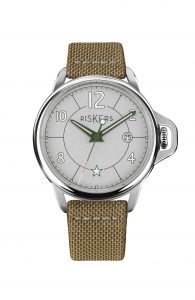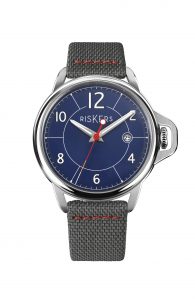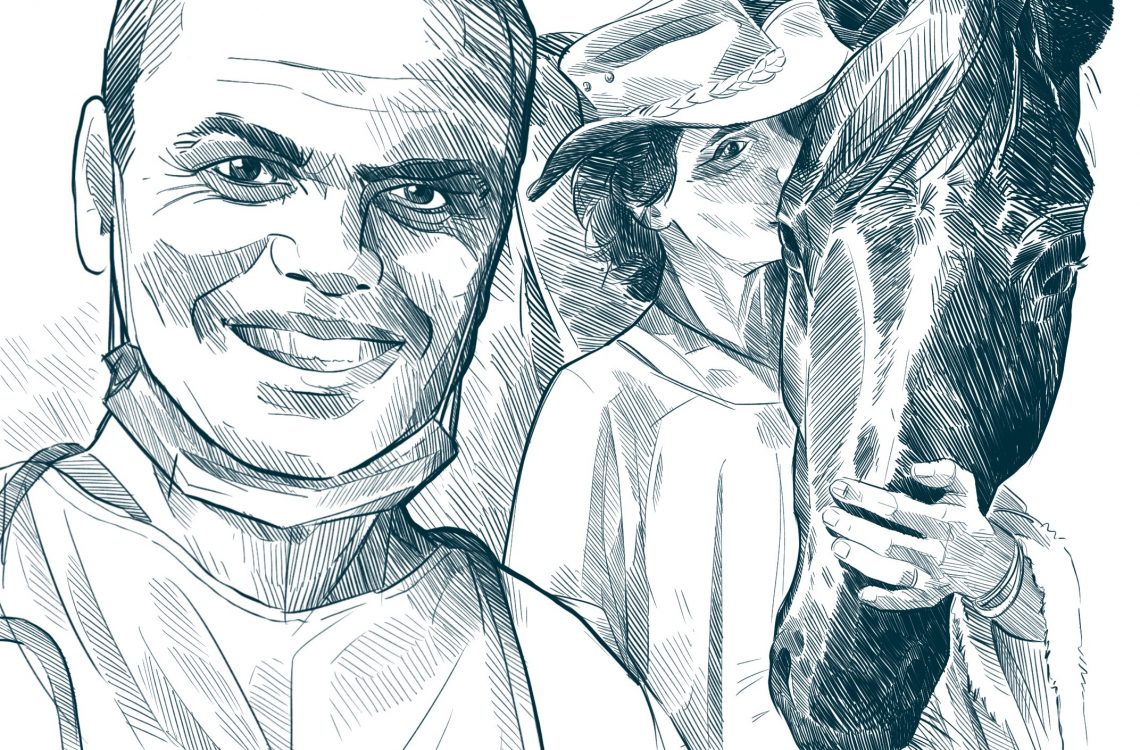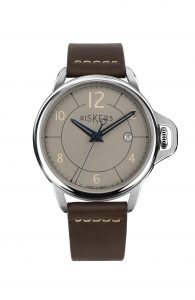The Riskers team wanted to mark the occasion of World Cancer Day by introducing you to the Hope association !
An adventure animated by two beautiful, committed personalities who co-founded it: Annabel Brourhant, artist, and Nicolas Chopin, cancer surgeon.
The objective of Hope is to accompany women who have been victims of cancer to help them recover physically and psychologically around a theme related to horses and painting.
Riskers: Could you tell us a few words about yourself. How did you get to this point? What was your trigger and why did you choose to do what you do today?
Nicolas Chopin: I have an initial surgical training in gynecology-obstetrics, as well as an over-specialization in cancer surgery for my clinical activity. At the same time, as I consider that research are fundamental elements of medical reflection, I trained in epidemiological research. Although I began to treat benign functional pathologies, I quickly realized that treating more serious illnesses physically and psychologically corresponded better to my desire to exercise and allowed me to fulfil myself better. One thing leading to another, I came to practice gynecological oncology, with the principle that the human being must be a central element of medical care beyond technology and technique.
Annabel Brourhant : I did a bit of theatre and then a school of communication. I worked as a journalist for 15 years. I had 4 children. At the third, I stopped working and without knowing why I suddenly started to suffocate. I felt I had to do something with my hands. I threw paint on my canvases. I do not know if you can call that being an artist, but I need to do things. When I found out I had cancer I, like most people with cancer, cried a lot, I was angry. When I make art, I forget everything for a moment. Through Hope, I wanted to show that when we have passions, desires to create, we forget the rest.
Riskers : What is your relationship with horse riding?
Nicolas Chopin: Quite simply, I have been a rider myself since my adolescence despite a long break during my studies and the beginning of my professional life. Horses are animals that fascinate, amaze, fascinate and move me.
Annabel Brourhant: Since I was a little girl, I always wanted to build my own stable. Just when I was finally about to realize my project, I fell ill, but that did not stop me from continuing along my path.
Riskers: Mrs. Brourhant, where do you get your inspiration? How do you transcribe the link between horses and illness in each of your works?
Annabel Brourhant: I have a very instinctive way of painting. Indeed, I neither learnt to paint nor to draw. But, strangely enough, when I show my canvases, people notice horses without me thinking about drawing them! Before my cancer, I was very stressed but not anymore. I may have learned to put my anxieties into my paintings.
Riskers: What do you think is the definition of “taking a risk”? What is the biggest risk you’ve ever taken?
Nicolas Chopin: In today’s world, the definition of risk remains subjective… For me, the real risk consists rather in risking one’s life for the benefit of others. In principle, this is rarely the case of the surgeon in the operating theatre… It is not so much me who takes risks daily, but rather my patients who are permanently obliged to manage risks: risk of this or that treatment, of this or that side effect, of this or that complication; risk of making this or that choice.
Annabel Brourhant: I never speak in terms of risk but rather in terms of objectives. I do what I want to do. Taking risks means moving forward without asking questions, even if it means giving up a certain comfort level, for me it means leaving my comfort zone.
Riskers: How did you meet?
Annabel Brourhant : At the age of 44 I learned that I had breast cancer, not very serious but still a cancer … I remember Nicolas and his team told me “we hesitate to remove your breast”. I replied: “go ahead with the breast I don’t care… But in 3 weeks I have to be on horseback”. And indeed, that’s what happened. We then became friends and decided to launch an associative project which mixes illness, resilience and riding therapy.
Riskers: How did you come up with the idea of combining riding therapy and therapeutic art?
Nicolas Chopin: Hope was born from our meeting, from a mixture of our ideas and above all from the communicative dynamism of Annabel, its president! Quickly during our consultations, once the medical discussions were over, we talked about her stable, horses and riding. We soon had the idea that mixing horse and cancer care could be interesting. Being riders ourselves, we were aware of the existence of a “mirror effect” between humans and horses. We thought it would be interesting to use this aptitude of the horse to accompany people in need of psychological support.
Annabel Brourhant: When we first started talking about it, we were told that it was a good idea. So I tested it. I took ten women from my village who had cancer, and together with a psychologist, a doctor and all the people who had surrounded me during my fight against the disease, we did a “test course”. And it was a success.
Riskers: How does riding therapy intervene in the physical and psychological healing process of a person formerly suffering from cancer?
Annabel Brourhant : Often, women arrive at the course without having cried or verbalized the injustice they are victims of. For me, to accept the illness is to acknowledge the fact that you are sick, to cry, to rebel and then to decide whether to do something about it, it is the first step towards recovery.
Nicolas Chopin: I would speak more about a process of physical and psychological accompaniment than about healing in relation to riding therapy. There is an important emotional charge during the courses thanks to this practice. The participants have made the choice in coming to the courses, for once, to take time for themselves, time to reflect, to verbalize what they have experienced. The idea is that these moments, facilitated by riding therapy but also by art therapy, allow them to become aware of the need for them to take care of themselves and help them to move forward in accepting their illness and regaining control of their lives. Moreover, riding therapy requires concentrating on the present moment and ignoring the daily annoyances which are unfortunately always numerous.
Riskers: Can you describe a riding therapy session?
Annabel Brourhant: There are two important things to know. None of my horses are trained for riding therapy and we do not let women riding them. Several people are present during the riding therapy sessions: a psychologist, a riding therapist, an art therapist, two volunteers, Nicolas and I. At the beginning, the women feel a lot of things, they often cry. The beginning of the day is a very important moment because everyone introduces themselves and talks about their journey, which already allows them to free their words. Then, in the second stage, the women form pairs who are assigned a horse. One of them holds the horse and the other one is blindfolded; it is thanks to this step that a relationship of trust is established. The riding therapist also brings the women to breathe at the same time as the horse does and makes them practice different exercises.
Nicolas Chopin: During our days, my role is to make the doctor more accessible since we have time to exchange. The relationship is no longer really from patient to doctor but from human being to human being because the context is radically different (no more hospital, no more white doctor’s gowns….). I also try to answer their medical questions based on scientifically validated medical knowledge. On this subject, I think it is vital to evaluate our practices in the future. Several avenues are being explored in order to be able to carry out this type of research in psychology and/or supportive care.
Riskers: Is it possible for women to form a bond with a particular horse?
Annabel Brourhant: It does indeed happen that women weave a particular bond with a horse. We often receive messages after the courses from women who ask us about the horses! As in human relationships, there are horses with whom it is an immediate crush and others a little less. Not every horse reacts in the same way according to the women.
Riskers: Is it possible that some women may initially feel a fear or reluctance towards horses? In such cases, how do you build women’s confidence?
Nicolas Chopin: We do not let women ride our horses, which potentially limits this type of anxiety! The setting and the atmosphere also play a big part, the place being very soothing and the atmosphere particularly benevolent.
Annabel Brourhant : We try to create a safe environment. They must all participate at least once in an art therapy and riding therapy session before making a choice about the therapy they will follow afterwards. Often, it is the beautiful encounter with the animal that pushes them to choose riding therapy.
Riskers: How to make a donation to HOPE? How to register for an internship for those who wish to do so?
Annabel Brourhant : Everything is on our website. Donations are made through “Helloasso” and all courses are online. We have four places dedicated to the courses. Reservations can also be made online. I would also like to point out that all the courses are free of charge.
Riskers: What aspect of Riskers inspires you the most?
Nicolas Chopin: All the values of Riskers speak to me, but everyone is free to interpret them differently. Courage is certainly the value that speaks to me the most. However, Albert Roche’s courage is obviously not the same as the courage we need to face our daily lives, however complicated they may be. Altruism also speaks to me a lot because it is the prerequisite of my profession.
Annabel Brourhant : Altruism. I have always been turned towards others but even more so since I was ill. Courage too because it is necessary when you are ill. Illness is a slap in the face!
Riskers: What is your favorite watch?
Nicolas Chopin: I own two. A Chapter 2 and a Chapter 3 that I gave to my wife for Christmas.
Annabel Brourhant: I have always liked watches, especially those with a leather strap. Of all of them, it is the Prolog 1 that inspires me the most.
Riskers: Which ambassador do you feel closest to?
Nicolas Chopin: Albert Roche fascinates me, there is a real physical and mental commitment behind his actions. But as a doctor, it is of course Pierre Muller who speaks to me the most.
Annabel Brourhant: Guillaume D’Aboville, because for me it is important to participate in education.
Quoted in this article: Swiss Made automatic watch PROLOG 1
Military watch CHAPTER 2

Quartz luxury watch CHAPTER 3



